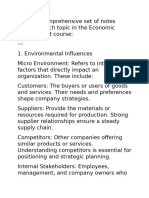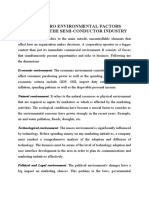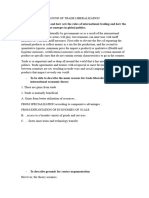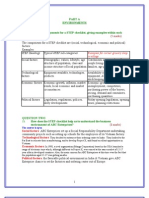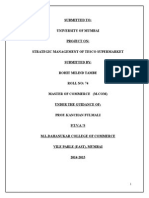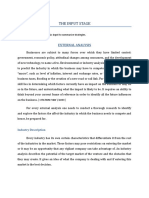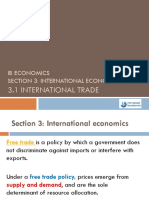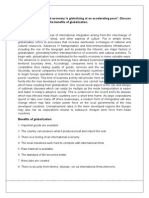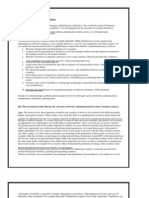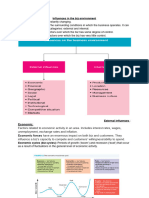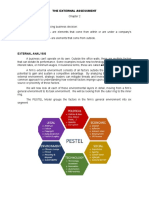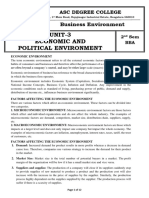0 ratings0% found this document useful (0 votes)
4 viewsTACN1
TACN1
Uploaded by
qduong1197Bussiness environment
Copyright:
© All Rights Reserved
Available Formats
Download as DOCX, PDF, TXT or read online from Scribd
TACN1
TACN1
Uploaded by
qduong11970 ratings0% found this document useful (0 votes)
4 views5 pagesBussiness environment
Copyright
© © All Rights Reserved
Available Formats
DOCX, PDF, TXT or read online from Scribd
Share this document
Did you find this document useful?
Is this content inappropriate?
Bussiness environment
Copyright:
© All Rights Reserved
Available Formats
Download as DOCX, PDF, TXT or read online from Scribd
Download as docx, pdf, or txt
0 ratings0% found this document useful (0 votes)
4 views5 pagesTACN1
TACN1
Uploaded by
qduong1197Bussiness environment
Copyright:
© All Rights Reserved
Available Formats
Download as DOCX, PDF, TXT or read online from Scribd
Download as docx, pdf, or txt
You are on page 1of 5
a) The business environment is divided into three main
types Macro-environment, Micro-environment and Internal
Business Environment.
Macro-environment has six main factors:
The first is Geographical and Ecological Factors:
Geographical conditions influence decisions regarding the
type of industry and business that can be conducted in a
specific region. This is because people from a particular
geographical area tend to have similar tastes, preferences,
and demands.
The second is Demographic Factors: The demographic
environment includes several sub-factors: the size, growth,
age, and sex of the population, education level, language,
class, religion.
The third is Economic Factors: The development or
decline of a business heavily depends on economic
conditions. A developing economy provides a favorable
business environment for maximizing economic growth.
The fourth is Political and Legal Factors: The political
and legal environment encompasses laws and government
policies related to business.
The fifth is Socio-cultural Factors: The social
environment concerns the environment of the entire society,
in which everyone participates. The cultural environment is
a combination of all subcultures with their distinct concepts,
beliefs, and values.
The last one is Technological Factors: Almost all goods
produced today are closely linked to the achievements of
science and technology.
b) The next is Micro-environment: There are five factors in
micro-environment
The first, Competition among sellers: In business and the
supply of goods and services, there will always be many
suppliers for a particular type of good or service, making
competition among sellers inevitable.
The second, Existence of substitute products and
services: In today's highly competitive economy, the
constant innovation of products and services is
understandable. With numerous production facilities
supplying products, these entities are compelled to
continuously innovate in the best ways to attract customers.
The third, New competitors: With rapid economic
development and expansion, many new businesses are
starting up. The increase in the number of businesses results
in numerous new competitors.
The fourth, Supplier power: Businesses are dependent on
suppliers of raw materials. If the dependence of businesses
is not significant, they can negotiate with suppliers.
Conversely, if the dependence on suppliers is high,
businesses will have limited bargaining power and may not
be able to negotiate the best prices.
And the last Buyer power: As we can easily observe and
compare, consumer demands are increasing, and the criteria
for choosing products and services are also rising. Meeting
the increasingly demanding criteria of consumers is one of
the challenges for businesses.
c) About Internal Business Environment
It refers to factors such as shareholders, business leaders,
employees, labor unions, scientists and experts, and sponsors.
The business environment is also an important factor. A good
business environment is also a good business environment for
businesses to develop.
2. The next I will talk about Analysis of
Business Environment
About Natural Geography and Ecology Factors:
In Vietnam Abundant natural resources such as minerals,
forests, seas, and rivers not only provide raw materials for
production but also create unique products with high value in the
international market. The country's favorable geographical
location facilitates connections with major markets, promoting
exports and attracting foreign investment.
However, frequent natural disasters such as storms, floods,
and droughts disrupt production, damage infrastructure, and
affect people's lives. The diverse and complex terrain hinders
infrastructure development and goods transportation, especially
in remote areas.
Demographics Factors:
Vietnam is currently experiencing a "demographic dividend"
with a young and dynamic population. The abundant labor force
not only provides a low-cost labor source for businesses but also
creates a large domestic consumer market. This attracts foreign
direct investment and stimulates economic growth.
However, the quality of the workforce remains a significant
challenge. Although there is an abundant labor force, the
proportion of highly skilled workers is still low, hindering efforts
to improve labor productivity and integrate into the global
economy.
Economy Factors:
Vietnam's GDP growth rate has been quite stable in recent
years, creating a favorable business environment. This attracts
both domestic and foreign investment and expands the market
scale. With a large population and increasing per capita income,
the Vietnamese domestic market is a large and promising
consumer market.
Politics and Law Factors:
Vietnam has maintained political stability for many years,
creating a relatively stable business environment. This attracts
foreign investment and promotes economic growth. Participation
in free trade agreements such as CPTPP and EVFTA has created
many export opportunities, reduced tariffs, and attracted foreign
direct investment.
Technology Factors:
The rapid development of technology is having a profound
and comprehensive impact on the business sector. The
development of automation technologies helps reduce manual
labor, increase productivity, and reduce production costs.
Moreover, the emergence of online sales allows businesses to
reach global customers, expanding their market quickly and
effectively. Therefore, businesses must constantly innovate to
keep up with trends and compete with rivals.
You might also like
- 6Document62 pages6anop83% (6)
- RectangularDocument11 pagesRectangulararifzakirNo ratings yet
- Dse720 Installation Instructions PDFDocument2 pagesDse720 Installation Instructions PDFanon_56872395776% (17)
- Economics EnvironmentDocument23 pagesEconomics EnvironmentgemuhdelphineNo ratings yet
- Final EconomicsDocument8 pagesFinal EconomicsNgoc Phuong Uyen LamNo ratings yet
- Macro Environment and MarketingDocument10 pagesMacro Environment and MarketingMohsin Khan100% (1)
- Unit 2 Business EnvironmentDocument31 pagesUnit 2 Business EnvironmentoxyshubhamNo ratings yet
- Bus. LogicDocument7 pagesBus. Logicjirentagalog0610No ratings yet
- Module IIDocument3 pagesModule IIPradeep RathodNo ratings yet
- Business Environment 3rd Unit NotesDocument11 pagesBusiness Environment 3rd Unit Notesnarayanapai9thabesNo ratings yet
- Example: Shortage of Components For Electronics, Vehicles, and Other Commercial ManufacturingDocument3 pagesExample: Shortage of Components For Electronics, Vehicles, and Other Commercial ManufacturingAiden PatsNo ratings yet
- MM Project 1Document7 pagesMM Project 1mitali.199022No ratings yet
- IBE Unit 2-2Document47 pagesIBE Unit 2-2bhagyashripande321No ratings yet
- Can The Emerging Technologies Pose A Challenge For An International Marketer? Give Valid Arguments ToDocument3 pagesCan The Emerging Technologies Pose A Challenge For An International Marketer? Give Valid Arguments ToElma RejanoNo ratings yet
- Nguyễn Diệu Tú - HS150490 - Individual assignmentDocument17 pagesNguyễn Diệu Tú - HS150490 - Individual assignmentChâu Nguyễn Ngọc MinhNo ratings yet
- GlobalisationDocument6 pagesGlobalisationAyush RahmanNo ratings yet
- A 2Document3 pagesA 2Husaynov HikmatNo ratings yet
- ExamDocument7 pagesExamgvjhbkjNo ratings yet
- Economic Environment DefinitionDocument16 pagesEconomic Environment Definitionshivam chaturvediNo ratings yet
- Unit 5 SlidesDocument24 pagesUnit 5 Slidessahana23720No ratings yet
- Part A Environments Question One Define The Components For A STEP Checklist, Giving Examples Within Each CategoryDocument19 pagesPart A Environments Question One Define The Components For A STEP Checklist, Giving Examples Within Each Categorys0o0No ratings yet
- Business - AssignmentDocument6 pagesBusiness - AssignmentMKaihnsaNo ratings yet
- Jonathan Greenberg Final MEF PP FileDocument28 pagesJonathan Greenberg Final MEF PP FilehuraldayNo ratings yet
- Opportunity SeekingDocument18 pagesOpportunity SeekingRellie Castro100% (4)
- Belab Unit 2Document37 pagesBelab Unit 2vartikajaiswal753No ratings yet
- IBM Unit 1Document40 pagesIBM Unit 1Udayashankara BNo ratings yet
- Strategic Management of TESCO Supermarket MLDCDocument40 pagesStrategic Management of TESCO Supermarket MLDCRohit Tambe100% (1)
- Zale Industry Analysis EditedDocument10 pagesZale Industry Analysis EditedJaveria RandhawaNo ratings yet
- Technological Environment Impacting Entrepreneurship: Submitted To:prof. Brajballav KarDocument6 pagesTechnological Environment Impacting Entrepreneurship: Submitted To:prof. Brajballav KarVedika AgrawalNo ratings yet
- International BusinessDocument13 pagesInternational Businessm.shehrooz23No ratings yet
- Case Study ONEDocument6 pagesCase Study ONENurazira SarmanNo ratings yet
- Marketing EnvironmentDocument7 pagesMarketing EnvironmentAda Araña DiocenaNo ratings yet
- Lequigan, Devine Grace - Economic Globalization & TradeDocument3 pagesLequigan, Devine Grace - Economic Globalization & Tradekaierlljhon11No ratings yet
- Macro IndustriesDocument6 pagesMacro IndustriesManasa SNo ratings yet
- Assignment 1Document3 pagesAssignment 1incorrectpass10No ratings yet
- Section 3.1 International Trade 6Document82 pagesSection 3.1 International Trade 6swssNo ratings yet
- Muhammad Danish Dar (9182024) (BBA-4C Evening) (Assignment 2)Document8 pagesMuhammad Danish Dar (9182024) (BBA-4C Evening) (Assignment 2)Danish DarNo ratings yet
- Question 1 - "The World Economy Is Globalizing at An Accelerating Pace". Discuss This Statement and List The Benefits of Globalization. Answer - 1Document7 pagesQuestion 1 - "The World Economy Is Globalizing at An Accelerating Pace". Discuss This Statement and List The Benefits of Globalization. Answer - 1Raghavendra SoniNo ratings yet
- Macro Business EnvironmentDocument9 pagesMacro Business EnvironmentAshok Chowdary GNo ratings yet
- Ventures Environment AssessmentDocument10 pagesVentures Environment AssessmentOloka George Okwir100% (2)
- International Business Strategy AssignmentDocument6 pagesInternational Business Strategy AssignmentPamNo ratings yet
- MB0053Document7 pagesMB0053garima bhatngar100% (1)
- BUS 100 Notes - CHP 1-3, 5, 7, 8 & 13Document48 pagesBUS 100 Notes - CHP 1-3, 5, 7, 8 & 13norhan alaliNo ratings yet
- Bba Notes For EnvironmentDocument25 pagesBba Notes For Environmentmohitbly856509No ratings yet
- Q1. Write A Note On Globalization. AnsDocument7 pagesQ1. Write A Note On Globalization. AnsBiplab KunduNo ratings yet
- Eco Assign 2Document4 pagesEco Assign 2rohanchintandesaiNo ratings yet
- CHAPTER 2 (Notes)Document5 pagesCHAPTER 2 (Notes)Dunga Mathonsi-JuniorNo ratings yet
- Biz Studies RevisDocument5 pagesBiz Studies Revissam12gouldNo ratings yet
- THE BUSINESS ENVIRONMENTAL ANALYSIS (External) - Lesson 3Document21 pagesTHE BUSINESS ENVIRONMENTAL ANALYSIS (External) - Lesson 3happy pillNo ratings yet
- International Business Unit 1Document25 pagesInternational Business Unit 1Mathumitha Muniappan100% (2)
- Chapter 2 THE EXTERNAL ASSESSMENTDocument11 pagesChapter 2 THE EXTERNAL ASSESSMENTPeter John SabasNo ratings yet
- International Business Business Transactions Crossing National Borders at Any Stage of The TransactionDocument10 pagesInternational Business Business Transactions Crossing National Borders at Any Stage of The TransactionakashiramkaNo ratings yet
- Forces Behind GlobalisationDocument2 pagesForces Behind Globalisationnikhil.trivediNo ratings yet
- BE 3rd Chapter NotesDocument12 pagesBE 3rd Chapter NotesKushal editzNo ratings yet
- International BusinessDocument22 pagesInternational BusinessHương GiangNo ratings yet
- A Project Report On Strategy Analysis of FMCG and FMCD (Electronic) IndustryDocument38 pagesA Project Report On Strategy Analysis of FMCG and FMCD (Electronic) IndustryChayan SenNo ratings yet
- Week 12 Revision QuestionsDocument3 pagesWeek 12 Revision QuestionsAmber YangNo ratings yet
- Marketing Environment Are Divided Into Two PartsDocument4 pagesMarketing Environment Are Divided Into Two Partstrinath1No ratings yet
- Real Estate Investing: Building Wealth with Property Investments: Expert Advice for Professionals: A Series on Industry-Specific Guidance, #2From EverandReal Estate Investing: Building Wealth with Property Investments: Expert Advice for Professionals: A Series on Industry-Specific Guidance, #2No ratings yet
- Acute Coronary Syndrome - Manchester Students 23.11.2020Document27 pagesAcute Coronary Syndrome - Manchester Students 23.11.2020Dalila ZildžićNo ratings yet
- IoT (15CS81) Module 5 Arduino UnoDocument30 pagesIoT (15CS81) Module 5 Arduino UnoRijo Jackson TomNo ratings yet
- T Rex Dinosaur Puzzle With Different Sizes and PosDocument18 pagesT Rex Dinosaur Puzzle With Different Sizes and PosOctavio DominguezNo ratings yet
- Easy Start Guide: WEG CFW-08 Frequency InverterDocument16 pagesEasy Start Guide: WEG CFW-08 Frequency Inverteralejandro man100% (1)
- Concept Paper OutlineDocument3 pagesConcept Paper OutlineChristian Joseph TiuNo ratings yet
- 2nd Quarter ReviewerDocument45 pages2nd Quarter ReviewerKrizzel ManimtimNo ratings yet
- Visions of A Modern Nation: Haiti at The World's Fairs St. Hubert, HadassahDocument225 pagesVisions of A Modern Nation: Haiti at The World's Fairs St. Hubert, HadassahJoanna Da Hora100% (1)
- Project Final Copy Under ProcessDocument147 pagesProject Final Copy Under ProcessVinod SinghNo ratings yet
- M54HC4094 M74HC4094: 8 Bit Sipo Shift Latch Register (3-State)Document12 pagesM54HC4094 M74HC4094: 8 Bit Sipo Shift Latch Register (3-State)marino246No ratings yet
- A Thesis On Contribution of Commercial Banks in Economic Growth of NepalDocument80 pagesA Thesis On Contribution of Commercial Banks in Economic Growth of Nepalmanoj sahNo ratings yet
- Assessment of Composting Technologies For OrganicDocument9 pagesAssessment of Composting Technologies For Organicsophia dwiratnaNo ratings yet
- Cheer DanceDocument4 pagesCheer DanceKler DaradarNo ratings yet
- King G., Custance D. - Colour Atlas of Vertebrate Anatomy - An Integrated Text and Dissection GuideDocument130 pagesKing G., Custance D. - Colour Atlas of Vertebrate Anatomy - An Integrated Text and Dissection Guidenozomi n.nNo ratings yet
- Experiment 4Document3 pagesExperiment 4mimiNo ratings yet
- Philippine Gods and GoddessesDocument4 pagesPhilippine Gods and GoddessesAngelo Capistrano100% (1)
- Design of An 8X8 Printed Circuit Board Dipole Phased Array Using HFSSDocument21 pagesDesign of An 8X8 Printed Circuit Board Dipole Phased Array Using HFSSwww_rtrNo ratings yet
- Water Pump AssembleSMCS 1361 016Document3 pagesWater Pump AssembleSMCS 1361 016Tawanda Tradyboy MorgansNo ratings yet
- Rapid Fire QuizDocument5 pagesRapid Fire QuizrashiNo ratings yet
- How To Use This-Wps OfficeDocument2 pagesHow To Use This-Wps OfficeBianca Benj ZariNo ratings yet
- Lenskart ReducedDocument5 pagesLenskart Reducedchowdharyanupam5No ratings yet
- The Long Dark 1st Draft Part 1Document1 pageThe Long Dark 1st Draft Part 1Essa ManamNo ratings yet
- Cidam-Pe 4Document2 pagesCidam-Pe 4Yehye Mamporte86% (7)
- General Mathematics: Functions and Their GraphsDocument5 pagesGeneral Mathematics: Functions and Their GraphsPrincess VillanuevaNo ratings yet
- Genetic Disorder Research Poster Project 12 5 17Document2 pagesGenetic Disorder Research Poster Project 12 5 17api-262586446No ratings yet
- Mathematical Induction Exercise PDFDocument4 pagesMathematical Induction Exercise PDFChai Usajai UsajaiNo ratings yet
- Homework Anthony TamayoDocument2 pagesHomework Anthony TamayoCooperativa Rio PastazaNo ratings yet
- Education: Integrated M.Tech - Mathematics and Computing - IIT, DhanbadDocument2 pagesEducation: Integrated M.Tech - Mathematics and Computing - IIT, DhanbadRohit SharmaNo ratings yet




